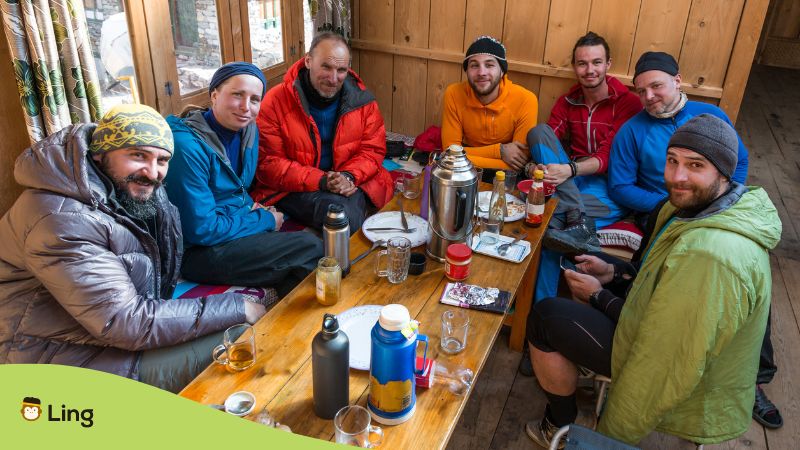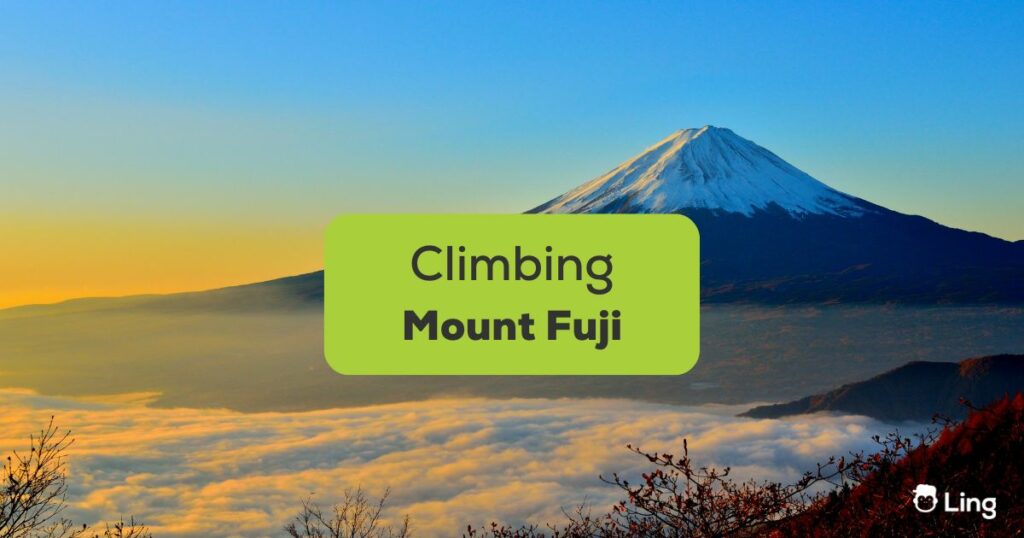Adventure seekers, it’s time to set our sights on one of Japan’s most iconic and awe-inspiring challenges – climbing Mount Fuji! At a whopping 3,776 meters (that’s 12,388 feet!), this beast of a mountain is one of the ultimate tests.
But before you start packing your bags and lacing up those hiking boots, know that climbing Mount Fuji, or Fujisan as it is called nowadays, is no joke. You’ll need serious stamina and a whole lot of prep. That means planning, picking the right gear, and even learning Japanese words and phrases. So, buckle up and get ready for the ultimate guide to tackling Japan’s highest mountain!
Table Of Contents
Timing Is Everything When Climbing Mount Fuji
First, let’s talk about timing. Mount Fuji’s official climbing season runs from early July to mid-September when the weather is generally mild, and the mountain is (mostly) free of snow. During this period, the trails and mountain facilities are open, so it’s prime time for most hikers.
Now, if you really want to avoid the crowds (and let’s be honest, who doesn’t?), I highly recommend aiming for a weekday climb in the first half of July before the school vacations start. Sure, the weather might be a tad unpredictable, but that’s all part of the thrill, right?
But what if you’re an avid hiker looking for an extra challenge? Well, you might want to consider climbing Mount Fuji off-season. Some mountain huts and facilities remain open until mid-September, and experienced climbers can even attempt the ascent in late June or early October (just be prepared for potential snow and icy conditions!).
Here’s a quick overview of the climbing season and what you can expect:
| Time Period | Description | Details |
|---|---|---|
| Early July – Mid-September | Official Climbing Season | -Trails and mountain facilities are open -Milder weather conditions -Increased crowds during school vacations |
| First Half of July | Recommended for Avoiding Crowds | -Before school vacations start -Weather unpredictable -Fewer hikers |
| Late June / Early October | Off-Season Climbing | -For experienced climbers -Potential snow and icy conditions -Some huts are closed |
| Mid-September – Late June | Highly Perilous Conditions | -Extreme wind -Weather and avalanche risks -Not recommended for most climbers |
The Trails: Choosing Your Path To Glory
So which Mount Fuji trail is gonna take you to the top? Mount Fuji boasts four main routes, and trust me, each has its own flavor. Picking the right one is very important, so let’s get into the good stuff:
| Trail | Altitude of 5th Station | Ascent Time | Descent Time | Highlights |
|---|---|---|---|---|
| Yoshida Trail | Around 2,300 meters (7,546 feet) | 5 to 7 hours | 3 to 5 hours | -Most popular and accessible -Separate trails for ascending and descending -Numerous mountain huts -Best for catching the sunrise from the summit |
| Fujinomiya Trail | Around 2,400 meters (7,874 feet) | 4 to 7 hours | 2 to 4 hours | -Shorter but steeper than the Yoshida Trail -No separate descent trail -Easily accessible from the Tokaido Shinkansen Line |
| Subashiri Trail | Around 2,000 meters (6,562 feet) | 5 to 8 hours | 3 to 5 hours | -Fewer crowds and mountain huts -Meets up with the Yoshida Trail near the 8th station -Great for a more off-the-beaten-path experience |
| Gotemba Trail | Around 1,400 meters (4,593 feet) | 7 to 10 hours | 3 to 6 hours | -Longest route to the summit -More time to soak in the incredible views -Few mountain huts along the way |
Remember, the trail you choose matters, but so does your pace. Fit as a fiddle? You might zoom to the top. But even then, don’t underestimate the climb. Always give yourself more time than you think you’ll need.
Gearing Up: Essential Equipment For Climbing Mount Fuji
We’ve talked trails, so now let’s talk about what’s going on in your backpack. Because, listen, the right gear can make your Mount Fuji climb epic. The wrong stuff? Well, let’s just say it’s not as fun. So let’s make sure you’ve got everything you need:
| Category | Essential Equipment | Additional Tips |
|---|---|---|
| Proper Hiking Shoes | -Sturdy, ankle-supporting boots with good traction | Break them in before your climb to avoid blisters. |
| Warm Clothing | -Base layers (moisture-wicking) -Insulating mid-layers (fleece or down jacket) -Waterproof and windproof outer layers -Hat, gloves, and warm socks | Keep warm in various weather conditions. |
| Headlamp or Flashlight | -Essential for early morning/late evening ascents | Headlamps preferable for hands-free use. |
| Hydration and Nutrition | -At least 2 liters of water -Energy-dense snacks (nuts, energy bars, dried fruit) -Electrolyte supplements or sports drinks | Adjust water intake if climbing in hot weather. |
| Sun Protection | -Sunscreen (SPF 30 or higher) -Lip balm with SPF -Sunglasses | Protect against UV rays throughout the climb. |
| First Aid Kit | -Bandages, antiseptic, blister treatment, and pain relievers | Be prepared for minor injuries and ailments. |
| Navigation | -Map and compass (or GPS device) -Whistle (for emergency signaling) | Essential for staying on track and safety. |
| Miscellaneous Items | -Trekking poles or walking stick -Garbage bags -Cash (for hut fees, toilets, provisions) -Spare batteries for electronic devices | Enhance stability, manage waste, ensure readiness for fees and power needs. |
Okay, here’s the golden rule: it’s way better to be overprepared than freezing your butt off halfway up. Fuji’s weather is unpredictable – one minute, sunshine, the next, it’s hailing! So bring the extra layers, those rain pants… whatever it takes to stay warm and dry.

Mountain Huts: Your Home Away From Home
Speaking of mountain huts, let’s talk about these Japanese accommodations that dot the trails of Mount Fuji. While they may not offer luxurious amenities, they provide a cozy and authentic respite for weary climbers.
Most hikers opt to tackle Mount Fuji for two days, spending the night at one of these mountain huts around the 7th or 8th station. Why? Two big reasons:
- Acclimatization: It allows your body to gradually adjust to the high altitude, reducing the risk of altitude sickness.
- Summit Timing: It puts you in a prime position to catch the breathtaking sunrise from the summit on the second day.
But what can you expect from these mountain huts? Here’s a quick rundown:
- Accommodation Style: Dormitory-style rooms with futon mats and shared facilities.
- Amenities: Basic but essential – no running water and toilets are typically not connected to plumbing.
- Provisions: Most huts offer meals (breakfast and dinner), snacks, water, and even canned oxygen for purchase.
- Cost: Overnight stays typically cost 9,000 to 14,000 yen ($58 to $91) per person, which includes two meals (breakfast and dinner).
- Reservations: Highly recommended during peak season, as these huts can get incredibly crowded, especially during Obon Week (mid-August).
- Day Use: If you’re not staying overnight, most huts offer paid access for a few hours, usually ranging from 1,000 to 3,000 yen ($6.50 to $19.50).
- Toilets: Be prepared to pay a small fee (typically 200-300 yen or $1.30-$1.95) for using the toilet facilities.
- Branding Irons: Many huts have special branding irons that they use to brand wooden hiking sticks for a small fee, creating a unique souvenir of your journey.
The huts are basic, and I get it. But that’s part of the charm! You’ll be swapping trail tales with hikers from all over, making new friends left and right, all while surrounded by the insane beauty of Mount Fuji. This isn’t your typical vacation, and that’s what makes it unforgettable.
Getting To Mount Fuji: Transportation Options
Okay, you’ve got the gear, and you know the mountain. Now, let’s get you to the start line! The good news is that Fuji is pretty easy to reach from all over Japan. They’ve got buses, trains, and the like. So, no matter where you’re starting from, Japanese transportation can make it happen.
From Tokyo
- Option 1: Hop on the Fuji Excursion train from Shinjuku Station – it’s a direct shot to Kawaguchiko (the start of the Yoshida Trail).
- Option 2: Take the JR Chuo line to Otsuki, then switch to the Fujikyu line (also gets you to Kawaguchiko).
- Option 3: During the climbing season, snag a direct bus from Shinjuku Station straight to the Subaru Line 5th Station on the Yoshida Trail. Easy peasy!
From Shizuoka Prefecture
Take the Tokaido Shinkansen to Shin-Fuji Station. From there, grab a shuttle bus to the 5th Station of your chosen trail (Fujinomiya, Subashiri, or Gotemba), but only during the climbing season.
By Car
- For the Yoshida Trail: Take the Tomei Expressway (exit at Yamanaka-ko) or the Chuo Expressway (exit at Kawaguchi).
- For the Subashiri Trail: Take the Tomei Expressway and exit at Gotemba.

Mount Fuji Etiquette: Respecting The Sacred Mountain
Look, Fuji isn’t just any mountain. In Japan, it’s practically a living legend, a symbol of strength, part of the Japanese culture, and all that good stuff. That means we gotta climb Mount Fuji with respect – not just so everyone has a good time, but to protect it for all the climbers who’ll come after us.
The “Leave No Trace” Code
- Trash Talk: Whatever you bring up, you must bring back down. Remember, there are no trash cans on the mountain, so pack a designated bag for garbage and bring it all down with you.
- No Picking Allowed: Those wildflowers sure are pretty, but they’re prettiest on the mountainside. The same goes for any cool rocks, branches, or anything else that catches your eye. Take photos, admire the view, but leave nature exactly as you found it.
- Animal Admiration: You might spot some unique critters up on Fuji. If you’re lucky, you might even see a Japanese serow (they look like mountain goats!). Keep your distance, be quiet, and enjoy the show.
Stick To The Path (It’s Not Just A Suggestion)
- Trailblazers? Nope: Those marked trails exist for a reason. They protect the fragile mountain environment and keep us from getting lost. No matter how tempting those shortcuts seem, stick to the official paths.
- Dress for Success (Sort Of): Sure, it’s a workout, but you should know that Mount Fuji is sacred. No need for suits and ties, but think about covering up a bit more than you would at the beach or gym.
Shhh… It’s Mountain Time
- Peace and Quiet: Some folks come to Fuji to find that epic, world-away-from-it-all silence. Keep the chatter low, especially early in the morning and near the summit. Let that mountain air and the sound of your own boots be the soundtrack for a while.
- Hut Harmony: Mountain huts are awesome, but they’re also shared spaces. Be prepared for noise from fellow hikers, respect the hut rules (shoes off, lights out at a certain time, etc.), and pitch in to keep those common areas tidy.
The Small But Important Stuff
- ID Please: You probably won’t need it, but it’s smart to carry a passport or ID card in your pack, just in case of an emergency or if a ranger asks.
- Chip In: During the climbing season, you’ll see donation boxes on the trails (usually around 1,000 yen or $6.50). This isn’t a fee—it’s your way to help keep Fuji beautiful. Maintenance, ranger support, keeping those trails in shape—your donation makes a difference!
Your Mount Fuji Survival Japanese
Remember me talking about learning some Japanese in the intro part? I wasn’t kidding! It’s not just about getting by. It’s like… a level-up for your whole Fuji adventure. Imagine saying こんにちは (Konnichiwa) to another hiker or thanking someone with a quick ありがとう(Arigatou). That connection is what makes it special.
| English Translation | Japanese Phrase | Use Case |
|---|---|---|
| Hello | Konnichiwa (こんにちは) | Works anytime, anywhere. |
| Excuse me | Sumimasen (すみません) | Perfect for crowds or grabbing someone’s attention politely. |
| Thank you very much | Arigatou gozaimasu (ありがとうございます) | Appreciation is always welcome, especially on the trail. |
| Good luck or Keep it up | Gambatte kudasai! (頑張ってください!) | Perfect for cheering yourself or fellow climbers on. |
| Just a little bit more | Mou sukoshi! (もう少し) | Motivational phrase for when the summit is close. |
| Are you alright? | Daijoubu desu ka? (大丈夫ですか) | For checking if someone looks like they’re struggling. |
| Go slowly, please | Yukkuri douzo (ゆっくりどうぞ) | Use to politely let a faster hiker pass you on the trail. |
| You seem to be in a hurry | Isogi desu ne (急ぎですね) | Acknowledge if someone is trying to pass you. |
| Great job | Otsukaresama deshita (お疲れさまでした) | Congratulate others (or yourself) after reaching the top. |
| Please be careful | Ki wo tsukete kudasai (気を付けてください) | Say if you notice a dangerous spot on the trail. |
| Excuse me for disturbing | Jama shimasu (邪魔します) | For squeezing past people at a mountain hut or rest area. |
| I’m sorry | Gomen nasai (ごめんなさい) | For those moments where you accidentally step on toes. |
| Where is the bathroom? | Toire wa doko desu ka? (トイレはどこですか) | The most important question of all! |
| It’s so beautiful | Kirei desu ne! (綺麗ですね) | Because you’ll definitely want to express your awe at the view. |
See what I mean? Even a tiny bit of Japanese shows you’re not just a tourist passing through. You’re actually respecting Fuji and the incredible people who climb it. Want to learn more? Try the Ling app! You can get it from Google Play and App Store and use it for FREE!
Time To Climb Mount Fuji!
Okay, I’ve thrown a lot at you, but now it’s your turn! Climbing Mount Fuji is a serious challenge, no doubt about it. But hey, if it was easy, everyone would be doing it, right? That summit moment, the sunrise… it’s the kind of thing that sticks with you forever. It proves there’s nothing you can’t climb, literally and in life.
Oh, those Japanese travel phrases we talked about earlier? They’re gold, trust me. Knowing a little Japanese goes a long way on Fuji, and everywhere else in Japan for that matter. So go for it, own that climb, and add “Mount Fuji conqueror” to your list of titles!



































































